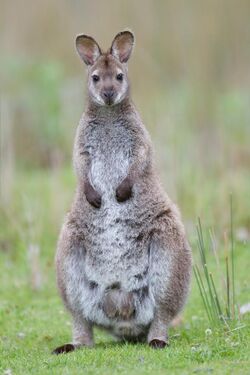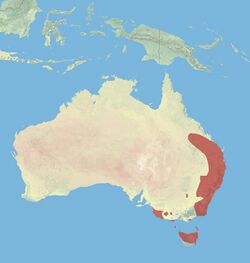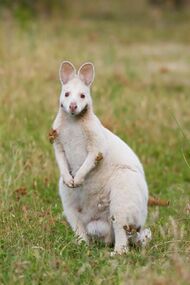Biology:Red-necked wallaby
| Red-necked wallaby[1] | |
|---|---|

| |
| Bennett's wallaby (N. r. rufogriseus), Bruny Island, Tasmania | |
| Scientific classification | |
| Domain: | Eukaryota |
| Kingdom: | Animalia |
| Phylum: | Chordata |
| Class: | Mammalia |
| Infraclass: | Marsupialia |
| Order: | Diprotodontia |
| Family: | Macropodidae |
| Genus: | Notamacropus |
| Species: | N. rufogriseus
|
| Binomial name | |
| Notamacropus rufogriseus (Desmarest, 1817)
| |
| Subspecies | |
|
N. r. rufogriseus | |

| |
| Red-necked wallaby's native range | |
| Synonyms[2] | |
| |
The red-necked wallaby or Bennett's wallaby (Notamacropus rufogriseus)[3] is a medium-sized macropod marsupial (wallaby), common in the more temperate and fertile parts of eastern Australia , including Tasmania. Red-necked wallabies have been introduced to several other countries, including New Zealand, the United Kingdom (in England and Scotland), Ireland, the Isle of Man, France and Germany .[4]
Description
Red-necked wallabies are distinguished by their black nose and paws, white stripe on the upper lip, and grizzled medium grey coat with a reddish wash across the shoulders. They can weigh 13.8 to 18.6 kilograms (30 to 41 lb) and attain a head-body length of 90 centimetres (35 in), although males are generally bigger than females. Red-necked wallabies are very similar in appearance to the black-striped wallaby (Notamacropus dorsalis), the only difference being that red-necked wallabies are larger, lack a black stripe down the back, and have softer fur.[5] Red-necked wallabies may live up to nine years.[6]
Distribution and habitat
Red-necked wallabies are found in coastal scrub and sclerophyll forest throughout coastal and highland eastern Australia, from Bundaberg, Queensland to the South Australian border;[6] in Tasmania and on many of the Bass Strait islands. It is unclear which of the Tasmanian islands have native populations as opposed to introduced ones.
In Tasmania and coastal Queensland, their numbers have expanded over the past 30 years because of a reduction in hunting pressure and the partial clearing of forest to result in a mosaic of pastures where wallabies can feed at night, alongside bushland where they can shelter by day. For not altogether clear reasons, they are less common in Victoria.
Behaviour

Red-necked wallabies are mainly solitary but will gather together when there is an abundance of resources such as food, water or shelter. When they do gather in groups, they have a social hierarchy similar to other wallaby species. A recent study has demonstrated that wallabies, as other social or gregarious mammals, are able to manage conflict via reconciliation, involving the post-conflict reunion, after a fight, of former opponents, which engage in affinitive contacts.[7] Red-necked wallabies are mainly nocturnal. They spend most of the daytime resting.[6]
A female's estrus lasts 33 days.[6] During courting, the female first licks the male's neck. The male will then rub his cheek against the female's. Then the male and female will fight briefly, standing upright like two males. After that they finally mate. A couple will stay together for one day before separating. A female bears one offspring at a time; the young stay in the pouch for about 280 days,[8] whereafter females and their offspring stay together for only a month. However, females may stay in the home range of their mothers for life, while males leave at the age of two. Also, red-necked wallabies engage in alloparental care, in which one individual may adopt the child of another. This is a common behavior seen in many other animal species like wolves, elephants, humans, and fathead minnows.[9]
Diet
Red-necked wallabies diets consists of grasses, roots, tree leaves, and weeds.[6]
Subspecies
There are two or three subspecies.
- N. r. banksianus (Quoy & Gaimard, 1825) - red-necked wallaby [Australian mainland]
- N. r. rufogriseus (Desmarest, 1817) sensu lato - Bennett's wallaby, which is sometimes replaced by:
- N. r. fruticus (Ogilby, 1838) [Tasmania]
- N. r. rufogriseus (Desmarest, 1817) sensu stricto [Bass Strait, King Island]
The Tasmanian subspecies, Notamacropus rufogriseus rufogriseus, usually known as Bennett's wallaby, is smaller (as island subspecies or species often are), has longer, darker[5] and shaggier fur, and breeds in the late summer, mostly between February and April. They have adapted to living in proximity to humans and can be found grazing on lawns in the fringes of Hobart and other urban areas.
The mainland Australian subspecies, Notamacropus rufogriseus banksianus, usually known as the red-necked wallaby, breeds all year round. Captive animals maintain their breeding schedules; Tasmanian females that become pregnant out of their normal season delay birth until summer, which can be anywhere up to 8 months later.
Introductions to other countries

There are significant introduced populations in the Canterbury Region of New Zealand's South Island. In 1870, several Bennett's wallabies were transported from Tasmania to Christchurch, New Zealand. Two females and one male from this stock were later released at Te Waimate, the property of Waimate's first European settler Michael Studholme. The year 1874 saw them freed in the Hunters Hills, where over the years their population has dramatically increased. Bennett's wallabies are now resident on approximately 350,000 ha of terrain in the Hunters Hills, including the Two Thumb Range, the Kirkliston Range and the Grampians. They have been declared an animal pest in the Canterbury Region and land occupiers must contain the wallabies within specified areas.[10] Bennett's wallaby is now widely regarded as a symbol of Waimate.
There are also small colonies in England[6] in the Peak District (extirpated), Derbyshire (extirpated), and the Ashdown Forest in East Sussex (population unknown). These were established ca. 1900. There are also other sightings frequently spotted in West Sussex and Hampshire and recently YouTuber 'Wildlife With Cookie' found a population in an unknown part of England not associated with the previous mentioned locations. One of this small population, was a mother carrying a joey, confirming that breeding was still occurring in the UK.[11] He also went on to locate wallabies with albinism in Kenilworth, Warwickshire[12]
There is a small colony of red-necked wallabies on the island of Inchconnachan, Loch Lomond in Argyll and Bute, Scotland. This was founded in 1975 with two pairs taken from the Whipsnade Zoo, and had risen to 26 individuals by 1993.[13]
There is a group of red-necked wallabies living wild on the Isle of Man, which are the descendants of numerous escapes from a wildlife park on the island in the 1960s and 1970s.[14] A 2017 study by estimated their number in the vicinity of the wildlife park to be 83 individuals, including a very small number of Parma wallabies.[15]
The Baring family, who owned Lambay Island off the eastern coast of Ireland, introduced red-necked wallabies to the island in the 1950s and 1960s. In the 1980s, the red-necked wallaby population at the Dublin Zoo was growing out of control. Unable to find another zoo to take them, and unwilling to euthanize them, zoo director Peter Wilson donated seven individuals to the Barings. The animals have thrived since then and the current population is estimated to be between 30 and 50.[16]
In France , in the southern part of the Forest of Rambouillet, 50 km (31 mi) west from Paris, there is a wild group of around 50–100 Bennett's wallabies. This population has been present since the 1970s, when some individuals escaped from the zoological park of Émancé after a storm.[17]
In Germany , around 10 wallabies live as a wild population in the federated state of Mecklenburg-Vorpommern since 2001.[18]
In October 2014, three captive Bennett's wallabies escaped into the wild in northern Austria and one of them roamed the area for three months before being recaptured, surprisingly surviving the harsh winter there. The case attracted media attention, as it humorously defeated the popular slogan "There are no kangaroos in Austria."[19]
Gallery
-
A joey in a pouch
-
A red-necked wallaby (N. r. banksianus)
-
juvenile
(N. r. rufogriseus) -
female and joey
(N. r. rufogriseus) -
White wallaby female
(N. r. rufogriseus) -
skull
References
- ↑ Groves, C. P. (2005). "Order Diprotodontia". in Wilson, D. E.; Reeder, D. M. Mammal Species of the World: A Taxonomic and Geographic Reference (3rd ed.). Johns Hopkins University Press. p. 65. ISBN 978-0-8018-8221-0. OCLC 62265494. http://www.departments.bucknell.edu/biology/resources/msw3/browse.asp?id=11000268.
- ↑ 2.0 2.1 McKenzie, N.; Menkhorst, P.; Lunney, D. (2008). "Notamacropus rufogriseus". IUCN Red List of Threatened Species 2008: e.T40566A21953329. doi:10.2305/IUCN.UK.2016-2.RLTS.T40566A21953329.en. https://www.iucnredlist.org/species/40566/21953329. Retrieved 28 December 2008.
- ↑ "Australian Faunal Directory: Notamacropus rufogriseus" (in en). https://biodiversity.org.au/afd/taxa/Notamacropus_rufogriseus.
- ↑ Dickinson, Greg (20 September 2018). "The curious mystery of the wild wallabies living on the Isle of Man" (in en-GB). https://www.telegraph.co.uk/travel/destinations/europe/united-kingdom/england/isle-of-man/articles/wallabies-isle-of-man/.
- ↑ 5.0 5.1 Staker, Lynda (2006). The Complete Guide to the Care of Macropods. Lynda Staker. p. 54. ISBN 0977575101. https://books.google.com/books?id=9P0COKdYFcMC&q=Red-necked+wallaby&pg=PA54.
- ↑ 6.0 6.1 6.2 6.3 6.4 6.5 Long, John (2003). Introduced Mammals of the World. Csiro Publishing. p. 40. ISBN 0643099166. https://books.google.com/books?id=7YC3cYhGMOcC&q=Red-necked+wallaby&pg=PA40.
- ↑ Cordoni, G.; Norscia, I. (2014). "Peace-Making in Marsupials: The First Study in the Red-Necked Wallaby (Macropus rufogriseus)". PLOS ONE 9 (1): e86859. doi:10.1371/journal.pone.0086859. PMID 24489796. Bibcode: 2014PLoSO...986859C.
- ↑ "Bennett's Wallaby". Encyclopedia of Life. http://www.eol.org/pages/133321.
- ↑ Riedman, Marianne L. (December 1982). "The Evolution of Alloparental Care in Mammals and Birds". Quarterly Review of Biology 57 (4): 405–435. doi:10.1086/412936.
- ↑ Law, Tina (28 March 2014). "Big bounce in South Island wallaby numbers". Stuff (Stuff). http://www.stuff.co.nz/business/farming/agribusiness/9878404/Big-bounce-in-South-Island-wallaby-numbers.
- ↑ "You Would NOT Expect To Find THIS In England | (Animal Anomalies)". YouTube. 2022-01-20. https://www.youtube.com/watch?v=oqp3YKz74pM. Retrieved 2022-06-17.
- ↑ "I Found Albino Wallabies WILD In The UK!". YouTube. 2022-02-07. https://www.youtube.com/watch?v=AJJr-50YA4E&t. Retrieved 2022-06-17.
- ↑ "The Colquhoun's Island". Inchconnachan Island – Loch Lomond. http://www.loch-lomond.net/theloch/inchconnachan.aspx.
- ↑ Parveen, Nazia (14 August 2016). "Wallabies flourishing in the wild on Isle of Man". The Guardian. https://www.theguardian.com/uk-news/2016/aug/14/wallabies-isle-of-man-wild-australia.
- ↑ Havlin, Paige; Caravaggi, Anthony; Montgomery, W. Ian (22 November 2017). "The distribution and trophic ecology of an introduced, insular population of red-necked wallabies (Notamacropus rufogriseus)". Canadian Journal of Zoology 96 (4): 357–365. doi:10.1139/cjz-2017-0090.
- ↑ Connolly, Colleen (2014-11-12). "What the Heck Are Wallabies Doing in Ireland?". http://www.smithsonianmag.com/science-nature/what-heck-are-wallabies-doing-ireland-180953304/.
- ↑ "Enquête sur le Wallaby de Bennett en Forêt d'Yvelines" (in fr). 2019. http://www.cerf78.fr/index.php/groupes-a-themes/mammalogie?layout=edit&id=51.
- ↑ as of 2. Dezember 2014.[|permanent dead link|dead link}}]
- ↑ "Runaway 'kangaroo' spotted in garden". The Local.at. 28 January 2015. http://www.thelocal.at/20150128/runaway-kangaroo-spotted-in-austrian-garden.
| Wikimedia Commons has media related to Macropus rufogriseus. |
External links
Further reading
- Latham, A. David M.; Latham, M. Cecilia; Warburton, Bruce (2018-06-11). "Current and predicted future distributions of wallabies in mainland New Zealand". New Zealand Journal of Zoology (Informa UK Limited) 46 (1): 31–47. doi:10.1080/03014223.2018.1470540. ISSN 0301-4223.
- English, Holly M.; Caravaggi, Anthony (2020-11-02). "Where's wallaby? Using public records and media reports to describe the status of red‐necked wallabies in Britain". Ecology and Evolution (Wiley) 10 (23): 12949–12959. doi:10.1002/ece3.6877. ISSN 2045-7758. PMID 33304507.
- Bentley, Ross (2018-08-18). "Could wallabies be about to colonise north Essex?". http://www.eadt.co.uk/news/environmentalists-views-on-wallabies-colonising-parts-of-east-anglia-1-5657677.
- McCarthy, Michael (2013-02-20). "The decline and fall of the Peak District wallabies". http://www.independent.co.uk/environment/nature/nature_studies/decline-and-fall-peak-district-wallabies-8503546.html.
- Caravaggi, Anthony; English, Holly (2020-11-03). "Wallabies are on the loose in Britain – and we've mapped 95 sightings". http://theconversation.com/wallabies-are-on-the-loose-in-britain-and-weve-mapped-95-sightings-148374.
- "Macropus rufogriseus". Atlas of Living Australia. https://bie.ala.org.au/species/NZOR-6-123977.
Wikidata ☰ Q109262323 entry
 |








